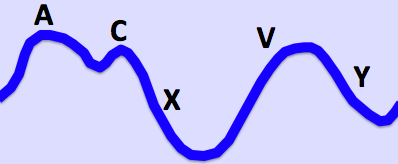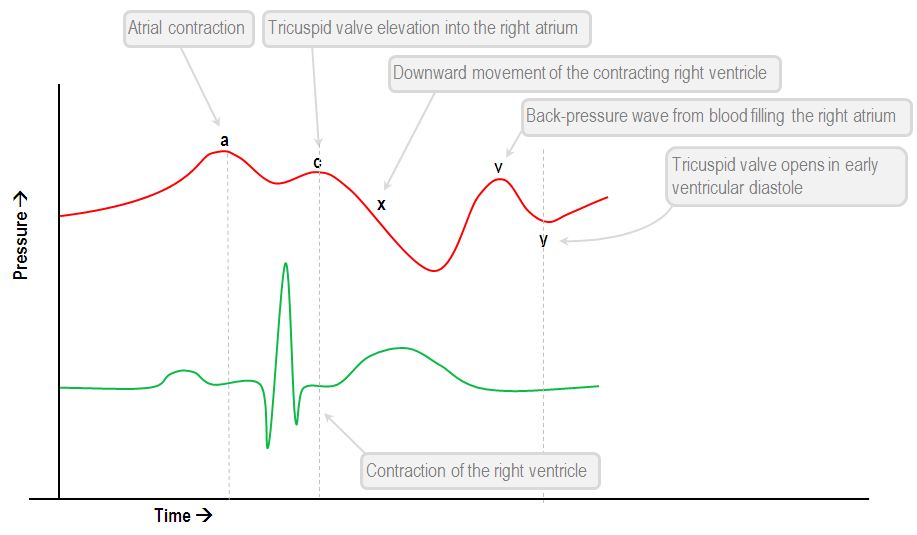.png)
Procedural Skills (SLO6)
Question 140 of 141

You are discussing the central venous pressure waveform in a teaching session for medical students. What does the x descent represent on the waveform?
Answer:
Following the c-wave is the first major descent in the CVP waveform, the x-descent. The x-descent is the movement of the right ventricle which descends as it contracts causing a drop in atrial pressure during ventricular systole. At this stage there is also atrial diastolic relaxation which further decreases the atrial pressure.Central Venous Pressure Waveform
Procedural Skills (SLO6)
Last Updated: 1st March 2021
Central venous pressure (CVP) is generally measured at the junction of the superior vena cava and the right atrium.
The normal CVP is about 0 - 8 mmHg.
Causes of raised CVP:
- Right ventricular failure
- Tricuspid stenosis or regurgitation
- Pericardial effusion or constrictive pericarditis
- Superior vena caval obstruction
- Fluid overload
- Hyperdynamic circulation
- High PEEP settings
Understanding the CVP waveform
A normal CVP waveform contains five components. These components include three peaks (a, c, v) and two descents (x, y). All of these components correspond to various aspects of the cardiac cycle.

Central Venous Pressure Waveform.
- The first peak is the a-wave, which immediately follows the p wave of the ECG waveform. The a-wave is a pressure increase that is due to atrial contraction at end-diastole.
- Shortly after the a-wave there is a second peak , the c-wave. The c-wave immediately follows the r wave of the ECG waveform. This is a pressure increase due to tricuspid bulging into the atrium as a result of ventricular contraction. Note that the a and c-waves are split by the r wave of the ECG waveform. This is because the a-wave always represents end-diastole and the c-wave represents early ventricular systole.
- Following the c-wave is the first major descent in the CVP waveform, the x-descent. The x-descent is the movement of the right ventricle which descends as it contracts causing a drop in atrial pressure during ventricular systole. At this stage there is also atrial diastolic relaxation which further decreases the atrial pressure.
- At the trough of the x-descent there is an increase in atrial pressure as the atrium begins to fill during late systole. This is called the v-wave. The v-wave corresponds to the end of the t wave in the ECG waveform.
- The final aspect of the CVP waveform is the y-descent, which is due to an atrial pressure drop as the tricuspid valve opens and blood enters the ventricle during diastole.
| Waveform Component | Phase of Cardiac Cycle | Mechanical Event |
|---|---|---|
| a wave | Atrial systole (end diastole) | Occurs due to right atrial contraction |
| c wave | Isovolumetric contraction (early systole) | Occurs due to the bulging of the tricuspid valve into the right atrium during right isovolumetric ventricular contraction |
| x descent | Rapid ventricular ejection (mid systole) | Occurs due to a combination of right atrial relaxation, the downward displacement of the tricuspid valve during right ventricular contraction, and the ejection of blood from both the ventricles |
| v wave | Ventricular ejection and isovolumetric relaxation (late systole) | Occurs due to right atrial filling from venous return |
| y descent | Ventricular filling (early diastole) | Occurs due to opening of the tricuspid valve and the subsequent rapid inflow of blood from the right atrium to the right ventricle |
Causes of abnormal CVP waveform
- Absent a-waves
- Atrial fibrillation
- Flutter of a-waves
- Atrial flutter
- Prominent a waves (increased resistance to flow from atrium to ventricle)
- Tricuspid stenosis
- Pulmonary stenosis
- Pulmonary hypertension
- Cannon a-waves (atrium contracts against a closed tricuspid valve)
- Ventricular tachycardia
- Junctional rhythm
- Complete heart block
- Prominent v-waves (backflow of blood out of contracting right ventricle)
- Tricuspid regurgitation
- Absent x-descent
- Tricuspid regurgitation
- Atrial fibrillation
- Rapid x-descent
- Constrictive pericarditis
- Cardiac tamponade
- Absent y-descent
- Cardiac tamponade
- Rapid y-descent
- Constrictive pericarditis
- Tricuspid regurgitation
- Slow y-descent
- Tricuspid stenosis
Report A Problem
Is there something wrong with this question? Let us know and we’ll fix it as soon as possible.
Loading Form...
- Biochemistry
- Blood Gases
- Haematology
| Biochemistry | Normal Value |
|---|---|
| Sodium | 135 – 145 mmol/l |
| Potassium | 3.0 – 4.5 mmol/l |
| Urea | 2.5 – 7.5 mmol/l |
| Glucose | 3.5 – 5.0 mmol/l |
| Creatinine | 35 – 135 μmol/l |
| Alanine Aminotransferase (ALT) | 5 – 35 U/l |
| Gamma-glutamyl Transferase (GGT) | < 65 U/l |
| Alkaline Phosphatase (ALP) | 30 – 135 U/l |
| Aspartate Aminotransferase (AST) | < 40 U/l |
| Total Protein | 60 – 80 g/l |
| Albumin | 35 – 50 g/l |
| Globulin | 2.4 – 3.5 g/dl |
| Amylase | < 70 U/l |
| Total Bilirubin | 3 – 17 μmol/l |
| Calcium | 2.1 – 2.5 mmol/l |
| Chloride | 95 – 105 mmol/l |
| Phosphate | 0.8 – 1.4 mmol/l |
| Haematology | Normal Value |
|---|---|
| Haemoglobin | 11.5 – 16.6 g/dl |
| White Blood Cells | 4.0 – 11.0 x 109/l |
| Platelets | 150 – 450 x 109/l |
| MCV | 80 – 96 fl |
| MCHC | 32 – 36 g/dl |
| Neutrophils | 2.0 – 7.5 x 109/l |
| Lymphocytes | 1.5 – 4.0 x 109/l |
| Monocytes | 0.3 – 1.0 x 109/l |
| Eosinophils | 0.1 – 0.5 x 109/l |
| Basophils | < 0.2 x 109/l |
| Reticulocytes | < 2% |
| Haematocrit | 0.35 – 0.49 |
| Red Cell Distribution Width | 11 – 15% |
| Blood Gases | Normal Value |
|---|---|
| pH | 7.35 – 7.45 |
| pO2 | 11 – 14 kPa |
| pCO2 | 4.5 – 6.0 kPa |
| Base Excess | -2 – +2 mmol/l |
| Bicarbonate | 24 – 30 mmol/l |
| Lactate | < 2 mmol/l |

